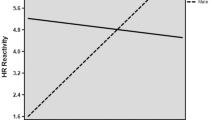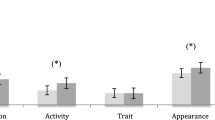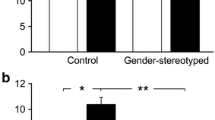Abstract
This study explored the effects of gender-typing of a task on cardiovascular reactivity among 60 men and 58 women, who were preselected on the basis of their “masculinity” and “femininity” scores on the Personal Attribute Questionnaire (PAQ; Spence & Helmreich, 1978). Both gender-role orientation and gender-typing of (he task (but not sex of participant) accounted for a significant amount of variance in systolic blood pressure (SBP) and heart rate (HR) reactivity. Femininity scores predicted increases in SBP responses to the task in the entire sample. HR responses were determined by a significant interaction of sex of participant, a “feminine” gender-role orientation, and gender-typing of the task. Among men, gender-typing of task interacted with gender-role orientation: men whose personality did not fit the situation (e.g., men scoring high on “femininity” who worked on a male-typed task) exhibited elevated MR reactivity. There were no significant effects for HR reactivity among women. These findings underscore the role of psychosocial factors as determinants of SBP and HR responses, especially among men.
Similar content being viewed by others
References
Allen, M. T., Stoney, C. M., Owens, J. F., & Matthews, K. A. (1993). Hemodynamic adjustments to laboratory stress; The influence of gender and personality.Psychosomatic Medicine.55, 505–517.
American Psychological Association. (1992). Ethical principles of psychologists and code of conduct.American Psychologist.47, 1597–1611.
Anderson, N. B. (1993). Reactivity research on sociodemographic groups: Its value to psychophysiology and health psychology.Health Psychology.12, 3–5.
Bem, S. L. (1974) The measurement of psychological androgyny.Journal of Consulting and Clinical Psychology, 42, 155–162.
Caplan, R. D. (1987). Person-environment Fit in organizations: Theories, facts and values. In A. W. Riley & S. J. Zaccaro (Eds.),Occupational stress and organizational effectiveness (pp. 103–140). New York: Praeger.
Chesney, M. A., Sevelius, G., Black, G. W., Ward, M. M., Swan, G. E., & Rosenman, R. H. (1981). Work environment. Type A behavior and coronary heart disease risk factors.Journal of Occupational Medicine.23, 551–555.
Collins, A., & Frankenhaeuser, M. (1978). Stress responses in male and female engineering students,Journal of Human Stress, 4, 43–48.
Ewart, C. K., &. Kolodner, K. B., (1991). Social competence interview for assessing physiological reactivity in adolescents.Psychosomatic Medicine, 53, 289–304.
Frankenhaeuser, M. (1978). Psychoneuroendocrine sex differences in adaptation to the psychosocial environment. In L. Carenza, P. Pancheri, & L. Zichella (Eds.).Clinical psychoneuroendocrinology in reproduction (pp. 215–334). London: Academic.
Frankenhaeuser, M. (1983). The sympathetic-adrenal and pituitary-adrenal response to challenge: Comparison between the sexes. In T. M. Dembroski, T. H. Schmidt, & G. Bluemchen (Eds.).Biobehavioral bases of coronary heart disease (pp. 91–105), Basel, Switzerland: Karger.
Frankenhaeuser, M. (1986). A psychobiological framework for research on human stress and coping. In M. H. Appley & R. Turnbull (Eds.),Dynamics of stress (pp. 101–116) New York: Plenum.
Frankenhaeuser, M. (1988). Stress and reactivity patterns at different stages of the life cycle. In P. Pancheri & L. Zichella (Eds.),Hiorhythms and stress in the physiopathology of reproduction (pp. 31–40). New York: Hemisphere.
Frankenhaeuser, M. (1991). The psychophysiology of workload, stress, and health: Comparisons between the sexes.Annals of Behavioral Medicine, 13, 197–204.
Frankenhaeuser, M., Lundberg, U., Frederikson, M., Melin, B., Tuomisto, M., Myrsten, A. L.. Hedman, M., Bergman-Losman, B., & Wallin, L. (1989). Stress on and ol'fthe job as related to sex. and occupational status in while-collar workers.Journal of Organizational Behavior, 10, 321–346.
Freedman, R. R., Sabharwal, S. C. & Desai, N. (1987). Sex differences in peripheral vascular adrenergic receptors.Circulation Research.61, 581–585.
Girdler, S. S., Turner, J. R.,. Sherwood, A., & Light, K. C. (1990). Gender differences in blood pressure control during a variety of behavioral stressors.Psychosomatic Medicine.52, 571–591.
Houston, B. K. (1988). Cardiovascular and neuroendocrine reactivity, global Type A, and components of Type A behavior. In B. K. Houston & C. R. Snyder (Eds.),Type A behavior pattern: Research, theory, and intervention (pp. 212–253). New York: Wiley.
Johansson, S. R., & Hjalmarson, A. (1988) Age and sex differences in cardiovascular reactivity to adrenergic agonists, mental stress and isometric exercise in normal subjects.Scandinavian Journal of Clinical Laboratory Investigation, 48, 183–191.
Lash, S. J., Eisler, R. M., & Schulman, R. S. (1990), Cardiovascular reactivity to stress in men: Effects of masculine gender role stress appraisal and masculine performance challenge.Behavior Modification, 14, 3–20.
Lash, S. J., Gillespie, B. L., Eisler, R. M.. & Southard, D. R. (1991). Sex differences in cardiovascular reactivity: Effects of the gender relevance of the stressor.Health Psychology, 10, 392–398.
Lawler, K. A., Allen, M. T., Critcher, E. C. & Standard, B. A. (1981). The relationship of physiological responses to coronary-prone behavior pattern in children.Journal of Behavioral Medicine.4, 203–216.
Light, K. C. (1981) Cardiovascular responses to effortful active coping: Implications for the role of stress in hypertension development.Psychophysiology, 18, 216–225.
Light, K. C., Dotan, C. A., Davis, M. K. & Sherwood, A. (1992), Cardiovascular responses to an active coping challenge as predictors of blood pressure patterns 10 to 15 years later.Psychosomatic Medicine, 54, 217–230.
Light, K. C., Sherwood, A., & Turner, J. R. (1992). High cardiovascular reactivity to stress, A predictor of later hypertension development. In J. K. Turner, A. Sherwood, & K. C. Light (Eds.).Individual differences in cardiovascular response to stress (pp. 281–293). New York: Plenum.
Light, K. C., Turner, J. R., Hinderliter, A., & Sherwood, A. (1993) Race and gender comparisons: 1 Hemodynamic responses to a series of stressors.Health Psychology.12, 354–365
Lundberg, U., de Chateau, P., Winherg, J., & Frankenhaeuser, M. (1981). Catecholamine and Cortisol excretion patterns in three year old children and their parents.Journal of Human Stress, 7, 3–11.
Matthews, K. A., Davis, M. C. Stoney, C. M., Owens, J. F., & Caggiula, A. R. (1991). Does the gender relevance of the stressor influence sex differences in psychophysiological response?Health Psychnlogy.10, 112–120.
Myrsten, A. L., Lundberg, U., Frankenhaeuser, M., Ryan, G., Dolphin, C., &. Cullen, J. (1984). Sex-role orientation as related lo psychological and physiological responses during achievement and orthostatic stress.Motivation and Emotion.8, 243–258
Saab, P. G. (1984). Cardiovascular and neuroendocrine responses to challenge in males and females. In N. Schneiderman, S. M. Weiss, & P. G. Knufmann (Eds.),Handbook of research methods in cardiovascular behavioral medicine (pp. 453–481), New York: Plenum.
Spence, J. T., & Helmreich, R. L. (1978).Masculinity and femininity Their psychological dimensions, correlates, and antecedents (pp. 29–38. 231–233). Austin. TX: University of Texas Press.
Statistical Package for the Social Sciences. (1986). United States. Library of Congress Cataloging in Publication Data (pp. 848–871). Chicago: SPSS. Inc.
Stoney, C. M. (1991). The role of reproductive hormones in cardiovascular and neuroendocrine function during behavioral stress. In J. R. Turner. A. Sherwood, & K. C. Light (Eds.),Individual differences in cardiovascular response to stress (pp. 147–163). New York: Plenum.
Stoney, C. M., Matthews, K. A., McDonald, R. H., & Johnson, C. A. (1988). Sex differences in lipid, lipoprotein, cardiovascular, and neuroendocrine responses to acute stress.Psychophysiology, 25, 645–656.
Stoney, C. M., Owens, J. F., Matthews, K. A., Davis, M. C., & Caggiula, A. (1990). Influences of the normal menstrual cycle on physiologic functioning during behavioral stress.Psychophysiology, 27, 125–135.
van Doornen, L. J. P. (1986). Sex differences in physiological reactions to real life stress and their relationship to psychological variables.Psyrhophysiolgy.23, 657–602.
van Egeren, L. F. (1979). Cardiovascular changes during social competition in a mixed-motive game.Journal of Personality and Social Psychology.37, 858–864.
Weidner, G. & Helmig, L. (1990), Menstrual cycle, mood and physiological stress reactivity.Women & Health.16, 5–21.
Weidner, G., & Messina, C. R. (1993. March).Sex-role orientation and cardiovascular reactivity to sex-typed tasks. Paper presented at the meeting of the Society of Behavioral Medicine. San Francisco, CA.
Author information
Authors and Affiliations
Additional information
The research was supported in part by National Heart. Lung, and Blood Institute Grants HL 3426103 anil HL4036802; the Suffolk County, NY. American Heart Association; and Biomedical Research Grant RR 0706721.
This article is based on a paper presented as part of a symposium on the role of gender in mechanisms of cardiovascular reactivity at the 1993 meeting of the Society of Behavioral Medicine. San Francisco.
We thank R. Friend. J. Hutt, and N. R. Mendell for their helpful comments on the article, and John Davis. Linda Helmig. Dennis Michaels. Gabrielle Pisano. and the late Tom Ficarrotto for serving as experimenters.
Rights and permissions
About this article
Cite this article
Weidner, G., Messina, C.R. Effects of gender-typed tasks and gender roles on cardiovascular reactivity. Int. J. Behav. Med. 2, 66–82 (1995). https://doi.org/10.1207/s15327558ijbm0201_6
Issue Date:
DOI: https://doi.org/10.1207/s15327558ijbm0201_6




